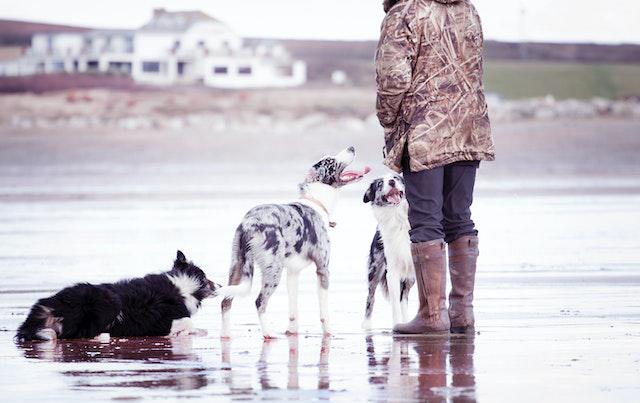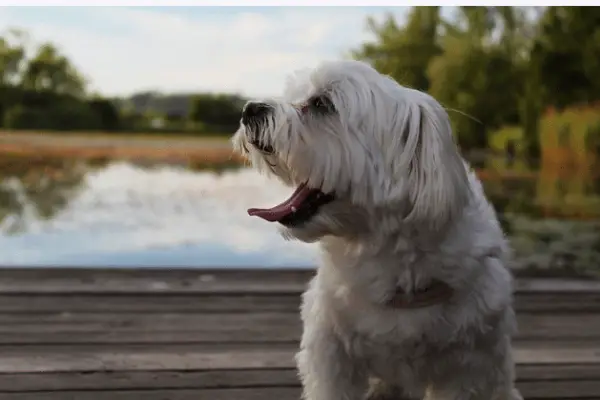Resource Guarding in Dogs [Signs, Causes, & Fixes]
![Resource Guarding in Dogs [Signs, Causes, & Fixes] Resource Guarding in Dogs](https://petcreeks.com/wp-content/uploads/2023/10/pexels-zen-chung-5749096.jpg)
Today, let’s dive into a topic that every dog owner should be aware of: resource guarding in dogs.
We all know how precious our furry friends’ possessions can be to them, but what happens when they become a little too possessive?
In this blog post, we’ll explore the fascinating world of resource guarding in dogs and share some tips on how to handle it like a pro.
So, grab a cup of coffee, get cozy, and let’s get started!
Resource Guarding in Dogs
Resource guarding in dogs is when they become possessive of items like food, toys, or beds. It’s a natural behavior, but it can become problematic if it leads to aggression.
To address resource guarding, it’s important to work with a professional dog trainer who can help modify the behavior through positive reinforcement techniques.
Understanding your dog’s body language and triggers can also help you prevent conflicts and create a safe environment for everyone.
Learn more about dog guarding food but not eating.
Signs of Resource Guarding in Dogs
![Resource Guarding in Dogs [Signs, Causes, & Fixes] Signs of Resource Guarding in Dogs](https://petcreeks.com/wp-content/uploads/2023/12/pexels-karolina-grabowska-4870869.jpg)
Resource guarding in dogs is a common behavior that owners should be aware of.
One major sign is growling or showing aggression when approached while eating or chewing on a bone.
Another is stiffening or freezing when someone gets near their food or toys. Dogs may also try to move their food or toys to a secluded area to guard them.
Some dogs might even snap or bite if someone tries to take away their prized possession. It’s important to observe these signs and address resource guarding early on to prevent escalation.
Remember, seeking professional help from a certified dog trainer or behaviorist can make a huge difference in managing this behavior.
Causes of Resource Guarding in Dogs
Resource guarding is a common behavior in dogs, and it can be caused by a variety of factors.
One major cause is a dog’s natural instinct to protect valuable resources such as food, toys, or even their favorite resting spot.
This behavior can also be influenced by a dog’s past experiences, such as not having consistent access to resources in the past, leading them to guard what they have more fiercely.
Additionally, insecurity or fear can trigger resource guarding in dogs, especially if they feel threatened by other animals or people.
Lack of proper socialization and training can also contribute to this behavior, as dogs may not have learned how to share or feel comfortable around others.
Health issues, such as pain or discomfort, can also lead to resource guarding as dogs may become more protective when feeling vulnerable.
Overall, understanding the causes of resource guarding can help owners address this behavior and work towards creating a safe and harmonious environment for their furry friends.
Consequences of Ignoring Resource Guarding in Dogs
Ignoring resource guarding in dogs can lead to escalated aggression and potentially dangerous situations.
It can erode the trust between the dog and its human family members, creating a tense and unpredictable environment.
This behavior may also result in injuries to humans and other pets, as the dog becomes more possessive and defensive of its resources.
Ignoring resource guarding can reinforce the behavior, making it more difficult to address in the future.
Therefore, it’s crucial to address resource guarding early on with positive reinforcement training and professional guidance to ensure the safety and well-being of everyone involved.
Addressing Resource Guarding in Dogs
![Resource Guarding in Dogs [Signs, Causes, & Fixes] Addressing Resource Guarding in Dogs](https://petcreeks.com/wp-content/uploads/2023/12/pexels-thiago-oliveira-8290787.jpg)
Here’s a step-by-step guide to help you address resource guarding in your dog:
Step 1: Recognize the Signs
The first step is to identify the signs of resource guarding. These may include growling, snarling, snapping, stiff body posture, or even biting when someone approaches their prized possessions. By understanding these signs, you can intervene early and prevent any potential escalation.
Step 2: Safety First
When dealing with resource guarding, it’s crucial to prioritize safety. Make sure to keep children and other pets away from the guarded item to avoid any potential conflicts or accidents. Additionally, always approach your dog cautiously and avoid any sudden movements that might trigger their guarding behavior.
Step 3: Manage the Environment
In the initial stages of addressing resource guarding, it’s essential to manage the environment to prevent any potential guarding situations. This may involve temporarily removing high-value items or implementing a controlled feeding routine. By setting up a controlled environment, you can minimize the chances of your dog practicing their guarding behavior.
Step 4: Counterconditioning and Desensitization
Counterconditioning and desensitization are effective techniques to modify resource guarding behavior. The goal is to change your dog’s emotional response to the presence of people or other animals near their valued possessions. Start by gradually exposing your dog to low-value items and rewarding them with treats or praise for remaining calm. Over time, work your way up to more valuable items, always rewarding positive behavior.
Step 5: Teach the “Drop It” or “Leave It” Command
Teaching your dog a reliable “drop it” or “leave it” command is crucial when addressing resource guarding. This command allows you to safely remove items from your dog’s possession without triggering their guarding behavior. Use positive reinforcement techniques to train your dog to willingly release items on command, rewarding them with treats or praise.
Step 6: Practice Patience and Consistency
Addressing resource guarding takes time and patience. It’s important to be consistent with your training efforts and practice regularly. Remember to remain calm and avoid punishment-based techniques, as they can escalate the guarding behavior and damage the trust between you and your dog.
Step 7: Gradual Exposure to Trigger Situations
As your dog progresses in their training, gradually expose them to situations that previously triggered resource guarding. For example, have someone approach while your dog is eating and reward them for remaining calm. This step helps your dog generalize their training and learn that the presence of others is not a threat to their resources.
Step 8: Seek Professional Help if Needed
If you’re facing challenges or if the resource guarding behavior persists despite your efforts, don’t hesitate to seek further professional help. A qualified behaviorist can provide additional guidance and support to address the issue effectively.
Learn more about dog training mistakes.
Preventing Resource Guarding in Dogs
When it comes to preventing resource guarding in dogs, fostering a positive association with approaching their food or toys is key.
Start by regularly adding treats to their bowl while they eat to reinforce that someone approaching means good things.
Teach the “drop it” command to encourage them to willingly release items.
Rotate their toys to avoid a possessive mindset, and always reward calm behavior around possessions.
Finally, engage in interactive play to strengthen the bond and trust between you and your furry friend.
Learn more about dog behavior concerns.
Frequently Asked Questions
What is resource guarding in dogs?
Resource guarding in dogs is when they become possessive or defensive over items like food, toys, or even their favorite napping spot. They might growl, snap, or even bite if someone tries to approach their resource.
Why do dogs exhibit resource guarding behavior?
Dogs may exhibit resource guarding behavior due to their natural instinct to protect valuable resources like food or toys. It can also be a learned behavior if they were not properly socialized or if they had to compete for resources in the past.
How can I tell if my dog is resource guarding?
Signs of resource guarding can include stiff body language, growling, showing teeth, or even snapping when someone approaches their resource. If your dog displays these behaviors, it’s important to address the issue in a positive and safe manner.
What should I do if my dog is resource guarding?
If your dog is exhibiting resource guarding behavior, it’s important to seek the help of a professional dog trainer or behaviorist. They can provide guidance on how to manage and modify this behavior using positive reinforcement techniques.
Can resource guarding be prevented in dogs?
Yes, resource guarding can be prevented through proper socialization, positive reinforcement training, and teaching your dog that it’s okay for people to approach their resources. It’s important to start this training early in your dog’s life.
Is resource guarding a serious issue?
Resource guarding can escalate into a serious issue if not addressed properly. It’s important to take it seriously and seek professional help to prevent any potential aggression or conflicts. With the right approach, resource guarding can be managed and improved over time.
Take away…
So, resource guarding in dogs is a common behavior, but it can be managed.
First, start by teaching your dog the “drop it” or “leave it” command to encourage them to willingly give up items.
Next, practice trading games where you exchange a low-value item for a high-value treat to show your dog that giving up possessions leads to positive outcomes.
Additionally, avoid taking things away forcibly, as this can exacerbate guarding behavior.
Consistency is key, so be patient and persistent in your training efforts. Lastly, seek guidance from a professional dog trainer or behaviorist for personalized advice and support. Good luck!
Conclusion
In a world where dogs are beloved members of our families, it’s important to address the issue of resource guarding.
By understanding the signs and implementing positive training techniques, we can create a safe and harmonious environment for our furry friends.
Let’s work together to ensure that every wagging tail feels secure and loved.




![How To Stop Puppy Biting Feet [Explained] How To Stop Puppy Biting Feet](https://petcreeks.com/wp-content/uploads/2023/02/How-To-Stop-Puppy-Biting-Feet-768x555.jpg)

